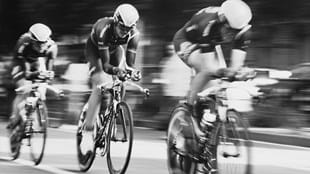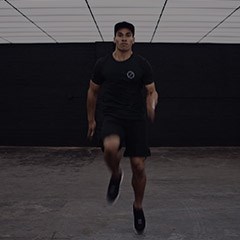High-Intensity Interval Training (HIIT) has become a mainstay of the fitness enthusiast’s training regime in recent years, thanks to the rapid changes it generates in both fitness levels and body composition. Backed by science, HIIT’s bursts of intensity have been proven to generate sensational results in record time. However, for some super-fit HIIT fans it seems that raising the bar and embracing Supramaximal Interval Training (SMIT) might deliver even more dramatic results. We caught up with Associate Professor Andrew Kilding, from AUT University, to explore the differences between the two training modes, and find out who should be incorporating SMIT in their training.
What are the main differences between SMIT and HIIT?
SMIT (also called “Speed Endurance Training”) and HIIT are both forms of interval training which involve intense bouts of exercise interspersed with periods of recovery or rest. The main difference between HIIT and SMIT is the intensity at which you exercise and the length of recovery between intervals.
V̇O2 max is the measurement of the maximum amount of oxygen that an individual can utilize during intense, or maximal exercise. It is a good indicator of both cardiorespiratory fitness and of endurance capacity during prolonged exercise. With HIIT, individuals usually perform efforts close to their maximal aerobic capacity (approximately 90-100 percent of their V̇O2 max). SMIT however, requires individuals to perform efforts well-above their V̇O2 max, with some research suggesting over 130 percent V̇O2 max. This is usually termed anaerobic or supramaximal exercise. As a result of the much higher work intensity, SMIT often has much longer recovery periods in between bouts. Work-to-rest ratios of HIIT are usually 1:1 or 1:2 whereas SMIT ratios can vary anywhere from 1:3 to 1:9.
What are the benefits of SMIT over HIIT?
The research on SMIT isn’t as advanced or as abundant as it is for HIIT. However a study examined the effects of SMIT versus HIIT training using endurance and sprint-based exercise in active females. Whilst HIIT proved more effective at improving 3000 meter running time trial performance (7.9 percent compared to 6.2 percent), it provided no additional benefit to sprint performance. SMIT however, was shown improve 40 meter sprint performance and repeated sprint ability, thus giving it a potentially wider range of performance benefits.
In another recent study, two groups of well-trained athletes were subjected to either HIIT or SMIT based exercise. Whilst both groups showed an increase in V̇O2 max and aerobic power, the athletes who were assigned to the SMIT group, completed 47 percent less training compared with the HIIT group. Therefore, SMIT training could be more efficient mode of training.
What happens to the body during SMIT compared to HIIT?
In order to sustain intense bouts of anaerobic exercise, such as during SMIT, individuals must rely upon several energy systems. Because of the high energy demand during SMIT, the two anaerobic energy pathways producing a large amount of energy will be the phosphocreatine [PCR] and glycolytic systems, supported by the aerobic energy system. However, energy supply from PCR and glycolysis is limited, and when performing exercise under anaerobic conditions the body produces many by-products (lactate, H+ ions, Inorganic Phosphates etc.) which all contribute to an imbalance of the body’s internal system causing us to fatigue or slow down.
During SMIT, the body produces a greater number of these by-products and therefore causes a larger physiological imbalance during the intense exercise bouts compared with HIIT. This then produces a larger oxygen debt within the body and increases post-exercise oxygen consumption (EPOC). Individuals are then having to work harder during their recovery phases (hence the increased recovery duration typically seen in SMIT compared to HIIT). These changes within the body are what researchers believe is the reason for the increased performance benefits shown in SMIT.
What type of exercise best lends itself to SMIT?
With the maximal nature of SMIT, it is difficult to apply it to some forms of exercise. SMIT mostly lends itself to cyclical sports such as cycling, running and rowing as high-intensity efforts (sprints) can be easily performed during these forms of exercise.
What type of sports does SMIT benefit?
A range of sports could benefit from SMIT. SMIT has been shown to increase V̇O2 max and fat oxidation; therefore any endurance based sports such as distance running, cycling, swimming and rowing could all benefit from SMIT. SMIT also enhances sprint performance, so any short distance track and field disciplines, shorter distance swimming, cycling and running events and also anaerobic based sports such as weightlifting would benefit.
Lastly, SMIT has been shown to improve repeated sprint ability, therefore team sports such as football, rugby, hockey, basketball, and netball would also benefit from SMIT.
How frequently should you do SMIT compared to HIIT?
New research highlights that spending no more than 30-40 minutes a week with your heart rate in the 90 percent max zone is ideal for optimizing the benefits of HIIT. Literature guiding the optimal amount of SMIT is limited and more research needs to be performed on what is too much, how much recovery is required and how this might influence the adherence to SMIT compared with other exercise modes.
How can you tell you are doing SMIT rather than HIIT?
Individuals will only know which mode of training they are completing by measuring the exercise intensity as they are working out and adjusting the recovery periods accordingly. Using a scientific approach, there are some specialized laboratory tests that can be conducted to determine an individual’s peak aerobic and anaerobic power and then intensities for SMIT can be guided from those.
What is most important – intensity or duration?
Both! Intensity and duration are two important factors to consider when designing and implementing a SMIT or HIIT training plan. By increasing the intensity you will ultimately decrease the duration a person can exercise for. The premise behind SMIT is about working very hard and then recovering before repeating. These bouts of very hard effort stimulate specific adaptations in the body. While HIIT is similar in the fact you work hard then recover, the intensity is relatively lower allowing the individual to perform for longer so there is probably more emphasis on accruing a given amount of time at higher intensity which in itself stimulates specific adaptations in the body.
Is it correct to say that SMIT is superior to HIIT?
Both methods can be effective, it comes down to what your training and performance goals are. If your performance goal is an endurance running event then it’s likely HIIT sessions will target the stimulation of your aerobic system for a prolonged period. If your goal is a supreme level of fitness, then a short and sharp SMIT program may be the exercise mode for you. Of note, however, is that several researchers have reported that an increased number of participants fail to complete the full SMIT program due to fatigue and this may compromise the gains achieved. In summary, it may be more agreeable to state that neither mode is better than the other.
Is SMIT something everyone should do?
No! SMIT exercise causes significant physiological and mechanical stress to the body as individuals are required to exercise at very high-intensities. Therefore, SMIT should only be recommended to individuals who are already recreationally active with no health contra-indications to performing high-intensity exercise. You should only begin to implement SMIT once you have progressively built up a tolerance to high-intensity exercise. Safety aside, the appropriateness of SMIT also depends on your training goals, your current training state and how much time you have for exercise.
If you want to experience the transformative benefits of interval training a LES MILLS GRIT or LES MILLS SPRINT workout should be your first port of call. Find a workout near you or work out On Demand.
If you want more health and fitness inspiration simply sign up to Fit Planet and get the freshest insights and advice straight to your inbox.








